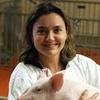Concentration, size distribution, and infectivity of airborne particles carrying PRRS, influenza A, and PED viruses emitted by acute infected animals
Published: March 25, 2024
By: C. Alonso 1, M. Torremorell 1, P. Davies 1, P. Raynor 2 / 1 Veterinary Population Medicine; 2 Division of Environmental Health and Science, University of Minnesota, St. Paul, United States.
Summary
Keywords: Particle size, Swine aerosols, Virus viability
Introduction:
When pathogens become airborne, they travel associated with particles of different size and composition. Particle size determines the distance across which pathogens can be transported, as well as the site of deposition and the survivability of the pathogen. Despite the importance of this information, the size distribution of particles bearing viruses emitted by infectious animals remains unknown. In this study, we characterized the concentration and size distribution of inhalable particles that transport influenza A virus (IAV), porcine reproductive and respiratory syndrome virus (PRRSV), and porcine epidemic diahrrea virus (PEDV) generated by acutely infected pigs, and assessed virus viability for each particle size range.
Materials and Methods:
Aerosols from experimentally infected pigs were sampled for 24 days using and Andersen cascade impactor able to separate particles by size (ranging from 0.4 to 10 micrometers (μm) in diameter). An optical particle counter was used to analyze total airborne particles during the sampling periods. Oral fluids, clinical signs, coughing and lethargy scores were collected daily. Air samples collected for the first 9, 20 and the last 3 days of the stuyd were analyzed for IAV, PRRSV, and PEDV respectively using quantitative RT-PCR and quanitified as a geometric mean copies/m3 within each size range. Virus viability was tested on specific cell cultures.
Results:
IAV was detected in all particle size ranges in quantities ranging from 5.5x102 (in particles ranging from 1.1 to 2.1 μm) to 4.3x105 RNA copies/m3 in the largest particles (9.0-10 μm). PRRSV was detected in all size ranges except particles between 0.7 and 2.1 μm in quantities ranging from 6x102 (0.4- 0.7μm) to 3.5x108 RNA copies/m3 (9.0-10μm). PEDV, an enteric virus, was detected in all particle sizes and in higher quantities than IAV and PRRSV (p< 0.0001) ranging from 1.3x106 (0.4-0.7 μm) to 3.5x108 RNA copies/m3 (9.0-10.0μm). Infectious status was demostrated for the 3 viruses, as a positive bioassay with the air samples for PEDV, and in the case of IAV and PRRSV, both viruses were isolated from particles larger than 2.1 μm.
Conclusion:
We investigated the particle concentration, size distribution, and infectivity of 3 animal viruses with different pathogenensis and transmission routes. IAV, PRRSV and PEDV emitted by infected pigs were found associated with a wide range of particle sizes that can deposit throughout the respiratory tract and later be swallowed. However, we demostrated that viability of airborne viruses was particle size dependent with IAV and PRRSV isolated only from particles > 2.1μm. Our results support the relevance of the aerosol route in the transmission of IA, PRRS and PED viruses.
Disclosure of Interest: None Declared.
Published in the proceedings of the International Pig Veterinary Society Congress – IPVS2016. For information on the event, past and future editions, check out https://ipvs2024.com/.
Content from the event:
Related topics:
Authors:
University of Minnesota
University of Minnesota
Recommend
Comment
Share

Would you like to discuss another topic? Create a new post to engage with experts in the community.







